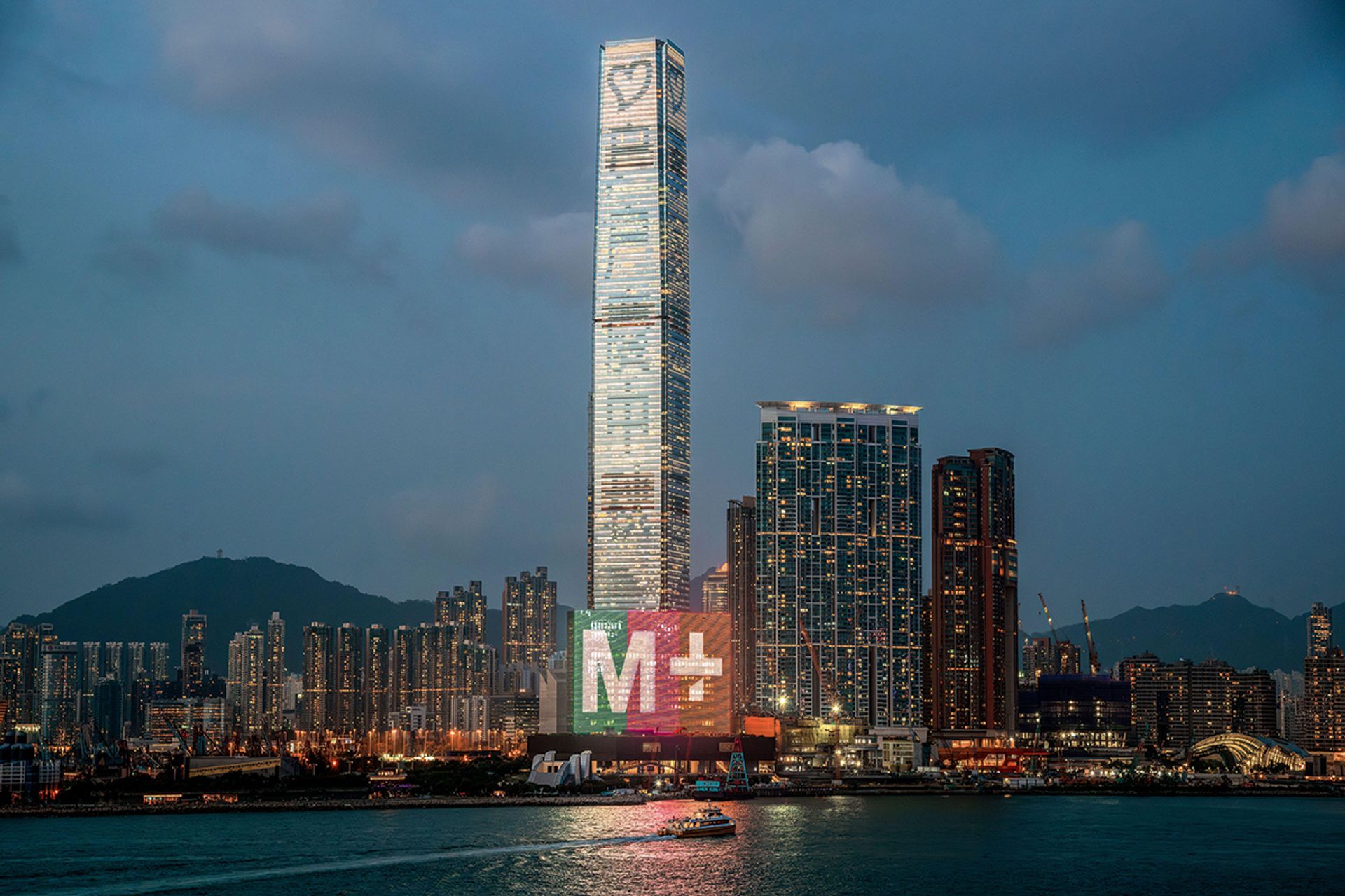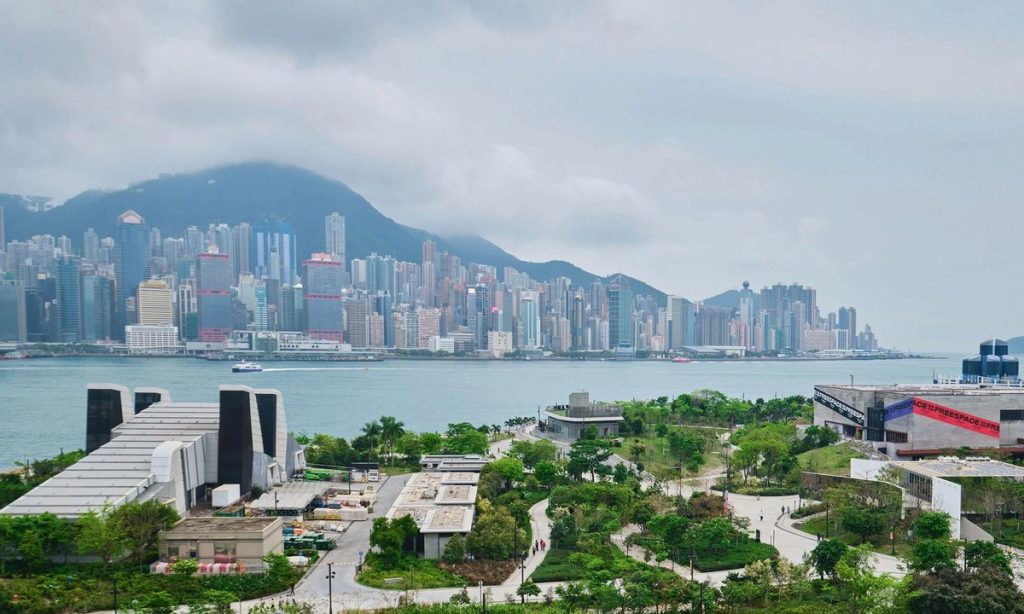Hong Kong politicians first mooted the idea of developing a world-class arts center on reclaimed land on the Kowloon peninsula in 1998, shortly after the former British colony was handed over to China. Advocates hailed Hong Kong as a “golden opportunity” that would put it on a par with other major cities, silencing criticism that it was a “cultural desert”. In 2008, the Hong Kong government provided the West Kowloon Cultural District Authority with an advance grant of HK$21.6 billion (US$2.8 billion) for the realization of the art center.
The megaproject is now one of the largest cultural districts in the world and a magnet for tourists, reinforcing Hong Kong’s image as a global city. Covering 40 hectares adjacent to Victoria Harbour, the precinct is home to the M+ Museum of Contemporary Visual Culture, the Hong Kong Palace Museum and two performing arts venues: Xiqu Center and Freespace. The Lyric Theater is under construction with the aim of opening in 2026.

Light up the city: the 110 m wide M+ Facade displays artworks programmed by the M+ museum, a building that doubles as London’s Tate Modern. Bob Henry/Alamy Stock Photo
After years of delays, the art center’s master plan reached a milestone in November 2021 with the highly anticipated opening of M+ in an impressive building nearly twice the size of London’s Tate Modern. Local Covid-19 restrictions forced the museum to close again in 2022 for more than two months, but it still managed to attract two million visitors in its first year.
Meanwhile, the Hong Kong Palace Museum was announced in late 2016 as an anniversary gift to celebrate Hong Kong’s return to China. The Beijing Palace Museum displays more than 900 bequeathed Chinese imperial treasures and attracted 1.3 million visitors in its first year of opening in July 2022. It has also produced high-profile exhibitions with international partners, such as the current tour. Masterpieces from the National Gallery, London (Botticelli to Van Goghuntil April 11).
Cultural exchanges
The global ambitions of the West Kowloon Cultural District are reflected in the international cultural conference it is hosting this week (entitled “Connecting Cultures, Bridging Times”). Among the speakers have been the artist Refik Anadol, the architect Ma Yansong and the heads of museums between Madrid, Doha, San Francisco and Tokyo. At the summit, cooperation agreements were signed between the neighborhood’s emblematic sites and more than 20 cultural institutions from around the world to “promote international cultural exchange and long-term partnerships.”

Additional annual operating expense: The Hong Kong Palace Museum was a surprise addition to the West Kowloon Cultural District in 2016. LT/Alamy Stock Photo
But against this optimistic backdrop, senior officials warn that the district faces significant financial challenges that could force it to halt future programming. West Kowloon Cultural District Authority (WKCDA) CEO Betty Fung told local media last summer that the Hong Kong government’s 2008 grant was expected to run out by March 2025.
The chairman of the authority, Henry Tang Ying-yen, recently confirmed this South China Morning Post WKCDA is awaiting approval of new funding arrangements proposed by the government last year. If no decision is made by June, the district will have to suspend contracts for future events. Tang told the newspaper, “I know I have no money and if I still sign a contract with an art group or an exhibition, it’s no different from writing a bounced check, which is illegal.”
Budget deficit
According to a source close to the Arts hub project Art Newspaper the budget hole has “always been there” since the endowment was made in 2008. The amount from the government was mainly to cover the capital expenditure to build and maintain the art galleries. Revenue to support their operating costs was expected to come from commercial leases for the site’s retail, dining and entertainment outlets.
Notably, the Hong Kong Palace Museum was not included in the scope of the original funding agreement. A late addition to the precinct in 2016, the Palace Museum project was funded by a HK$3.5 billion donation from the Hong Kong Jockey Club Charities Trust. Maintaining the Palace Museum costs about HK$400 million ($52 million) annually in operating expenses.
The government slapped WKCDA with an “enhanced financial arrangement” in 2016, allowing part of the site to be tendered to private developers of hotels, offices and residential units to generate additional rental income. But the timing of the bidding during the pandemic and a weakened real estate market “diminished the appetite of developers for investment,” he says. South China Morning Post.
Details of WKCDA’s new financial proposal to the government have not been disclosed, however Art Newspaper understands the plan based on the right to sell properties on the site. Due to existing government restrictions, WKCDA can only rent out housing.
The authority “always planned to cover the gap [in the budget] with the sale of real estate”, says an anonymous source Art Newspaper. “The lack of income during the Covid pandemic was also problematic.”
The district, however, has moved forward with a major commercial initiative. In November 2022, it awarded a 47-year tender to a subsidiary of Sun Hung Kai Properties, one of Hong Kong’s largest developers, to build and operate three office towers near M+ and the Lyric Theater Complex. “This achievement against a backdrop of economic uncertainty marks a critical juncture for WKCDA, paving the way for the next phases of the hotel/office/residential development plan,” says a WKCDA spokesperson.
The spokesperson added that the district is seeing “positive results” in its efforts to reduce costs and increase revenue. In 2022/23, for example, M+ and the Hong Kong Palace Museum recovered almost half of their respective operating costs (46% and 44%) through self-generated income. Overall, the district’s commercial rental income nearly quadrupled over the same period, while fundraising income grew “sixfold” to HK$197 million. “Through diligent efforts, we have successfully postponed the potential financial shortfall to mid-2025,” the spokesperson said.
As the clock ticks down, the Hong Kong government says it is trying to fix the cultural district’s financial woes. “The government is actively exploring solutions,” said Kevin Yeung Yun-hung, Hong Kong’s Secretary of Culture, Sports and Tourism. the standard newspaper. “We are dedicated to working together with the government of the Hong Kong Special Administrative Region to come up with a sound and sustainable financial plan for the West Kowloon Cultural District,” said a WKCDA spokesperson.
Incentives for visitors
Local cultural professionals believe that new tax relief schemes could encourage private philanthropy where public funding is lacking.
It’s not just about direct income, just consider its value to tourism and hospitality businesses
Uli Sigg, collector and former ambassador to China
“I would like to give you some additional reasons to visit the districts,” says David Ahlstrom, a business professor at Hong Kong Metropolitan University. “I’m not criticizing the project, but my impression over the years has been: Why aren’t there small things like restaurants and themed shops, not just the big ticket attractions, to bring people into the neighborhood?”
A WKCDA spokeswoman says the district’s “long-term financial strategy” is to generate revenue from “multiple sources,” including ticketing, patronage, commercial leasing, as well as hotel, office and residential developments, adding that “it will take some time.” to realize the full revenue potential of our commercial projects”.
This week’s museum summit reflects how far Hong Kong has already come as a growing cultural hub. Uli Sigg, the collector and former Chinese ambassador who donated more than 1,400 works of contemporary Chinese art to M+ in 2012, is keeping faith with the city’s art district. West Kowloon “will have a sustainable future,” he said Art Newspaper. “It’s not just direct revenue, consider its value to tourism and hospitality businesses, like MoMA does for New York or Tate for London. Why would a city push a project like this for billions and then abandon it halfway through? before reaping its fruits, culturally and economically?


